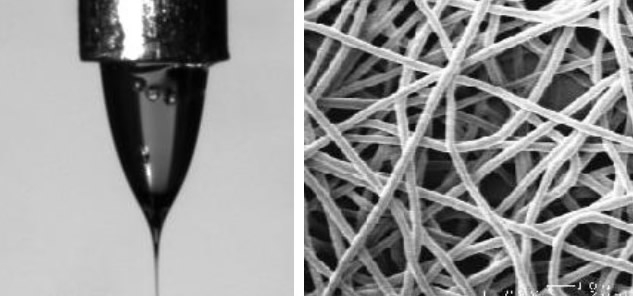Electrospinning and Polymer Nanofibers: I. Process Fundamentals
Personnel: J.H. Yu, S.V. Fridrikh
Sponsorship: NTC, US Army ISN (sponsor contact information)

Electrospinning is a process that employs electrostatic forces to produce polymer fibers, ranging in diameter from microns down to tens of nanometers. Due to the high surface area and very small size of electrospun nanofibers, they have a variety of applications: tissue scaffolding, highly efficient filtration membranes, nanowires, and nanocomposites. In our research on electrospinning, we are pursuing two complementary goals. One is to develop a physical understanding of electrospinning through development of hydrodynamic models of the process and checking against experiment. The other is to explore the applications of electrospun fibers. We have developed a simple model capable of predicting the final jet and fiber diameter as a function of processing parameters and material properties. Recently, we advanced this model to properly account for non-linear effects such as stretching of the jet and strain hardening, and to describe the evolution of the whipping jet from the onset of the instability to the moment it hits the collector. The effect of solvent evaporation can also be incorporated into the model; our preliminary results show that it plays an important role in determining the amplitude of the whipping instability. Using insights from the model, we have recently developed a method to electrospin fibers from materials that would otherwise be difficult or impossible to process by conventional electrospinning.

Our studies of the process fundamentals in this field are directed towards providing a better understanding of electrospinning and to optimize the production of electrospun fibers. We have previously reported simple analytical models for the steady thinning jet and the competition of instabilities that eventually terminate the steady jet, and confirmed their predictions experimentally [Polymer 42, 9955 (2001)]. We also introduced and confirmed the existence of the “terminal jet”, whose diameter defines the lower bound on the size of nanofibers formed by electrospinning [Phys. Rev. Lett. 90, 144502 (2003)]. Based on this knowledge, we designed a two-fluid electrospinneret and demonstrated it utility to make fibers with a core/shell structure, to process fluids that would otherwise unspinnable, and to make fibers with a smaller terminal diameter than would be possible using a single fluid electrospinneretts [Adv. Mater. 16, 1562, (2004)]. We further explore the influence of processing parameters, such as flow rates, on the fiber diameter. At low flow rate, the inner fluid cannot entrain into the outer fluid steadily. As a result, the core of the fiber becomes discontinuous. At the other extreme, when the inner fluid flow rate is too high it cannot be encapsulated and entrained by the outer fluid, and spraying occurs. We are currently exploring the narrow window of inner and outer fluids flow rates wherein fibers with a uniform core and shell are produced. We also recognize the importance of elasticity in determining the final morphology of electrospun fibers. For this purpose, we have developed a series of model poly(ethylene oxide) solutions to illustrate its role. We have quantified the transitions from electrospraying to electrospinning, and from a beads-on-string morphology to uniform fibers in terms of solution rheological properties. Our aim is to use solution properties, such as elasticity and surface tension to control the electrospinnability of the solution.